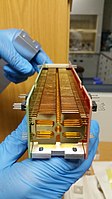
Photo from wikipedia
Ion mobility-mass spectrometry has emerged as a powerful tool for interrogating a wide variety of chemical systems. Collision-induced unfolding (CIU), typically performed in time-of-flight instruments, has been utilized to obtain… Click to show full abstract
Ion mobility-mass spectrometry has emerged as a powerful tool for interrogating a wide variety of chemical systems. Collision-induced unfolding (CIU), typically performed in time-of-flight instruments, has been utilized to obtain valuable qualitative insight into protein structure and illuminate subtle differences between related species. CIU experiments can be performed relatively quickly, but unfolding energy information obtained from them has not yet been interpreted quantitatively. While several methods can determine quantitative dissociation energetics for small molecules, clusters, and peptides, these methods have rarely been applied to proteins, and never to study unfolding. Here, we present a method to rapidly determine activation energies for protein unfolding and dissociation, built on a model for energy deposition during collisional activation. The method is validated by comparing activation energies for dissociation of three complexes with those obtained using blackbody infrared radiative dissociation (BIRD); values from the two methods are in agreement. Several protein monomers were unfolded using CIU, including multiple charge states of both cations and anions, and activation energies determined. ΔH⧧ and ΔS⧧ values are found to be correlated, leading to ΔG⧧ values that lie within a narrow range (∼70-80 kJ/mol) and vary more with charge state than with protein identity. ΔG⧧ is anticorrelated with charge density, highlighting the key role of Coulombic repulsion in gas-phase unfolding. Measured ΔG⧧ values are similar to those computed for proton transfer within small peptides, suggesting that proton transfer is the rate-limiting step in gas-phase unfolding and providing evidence of a link between the Mobile Proton model and CIU.
Journal Title: Journal of the American Society for Mass Spectrometry
Year Published: 2020
Link to full text (if available)
Share on Social Media: Sign Up to like & get
recommendations!